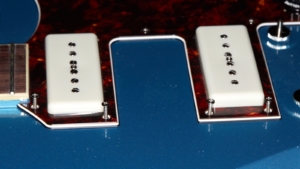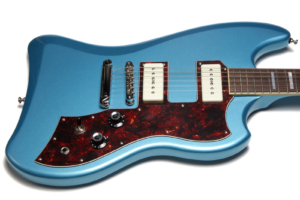 Today’s guitar is a Guild T-Bird ST P90 in Pelham Blue from the Newark St. collection. I scored this guitar in mint condition for a great price and had to buy it because it’s a fairly interesting combination of pickups, body shape, tailpiece layout, and controls. Plus it’s a Guild so the urge was appropriately amplified.
Today’s guitar is a Guild T-Bird ST P90 in Pelham Blue from the Newark St. collection. I scored this guitar in mint condition for a great price and had to buy it because it’s a fairly interesting combination of pickups, body shape, tailpiece layout, and controls. Plus it’s a Guild so the urge was appropriately amplified.
I’ve reviewed a 1964 S200 Guild Thunderbird, a 2016 Newark Street S200 T-Bird, and a 2017 Newark Street T-Bird ST, so what’s one more? Let’s take a look and see how this guitar fares when compared with its similarly shaped brethren.
Introduction
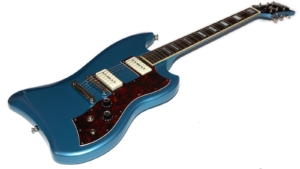 The S200 Guild Thunderbird is a pretty iconic guitar these days selling for some pretty serious money, so when Guild released a modern import version of it, there was much rejoicing (queue 20-minute Monty Python quote-fest). Both guitars suffer from some excessive complexity in my opinion, though to be fair that complexity allows for some serious options when it comes to the guitar’s tone. Guild very smartly thought that a simpler option might sell which led to the T-Bird ST models. At least, that’s what I assumed happened because that’s what I would have done and it only makes sense to assume that anything I would have done would be what the rest of the world would do. Right?
The S200 Guild Thunderbird is a pretty iconic guitar these days selling for some pretty serious money, so when Guild released a modern import version of it, there was much rejoicing (queue 20-minute Monty Python quote-fest). Both guitars suffer from some excessive complexity in my opinion, though to be fair that complexity allows for some serious options when it comes to the guitar’s tone. Guild very smartly thought that a simpler option might sell which led to the T-Bird ST models. At least, that’s what I assumed happened because that’s what I would have done and it only makes sense to assume that anything I would have done would be what the rest of the world would do. Right?
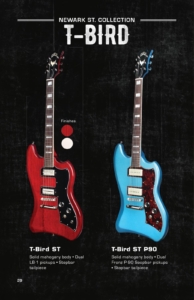 The T-Bird STs do not support the S200 model number like the S200 T-bird, possibly because of the simplified control layout and stop tail. Well, that’s certainly why they have ST in their names, but my assumption is that they wanted to differentiate these and make them more moden or something. I don’t know. I just needed enough words to fill up this section so that it wrapped around that long-ass catalog page.
The T-Bird STs do not support the S200 model number like the S200 T-bird, possibly because of the simplified control layout and stop tail. Well, that’s certainly why they have ST in their names, but my assumption is that they wanted to differentiate these and make them more moden or something. I don’t know. I just needed enough words to fill up this section so that it wrapped around that long-ass catalog page.
The 2018 catalog shows this guitar on page 29 along with the sexy Newark Street T-Bird ST. I love me some P-90s, so let’s see how this guitar fares after being abused by this Westerly-Guild-loving fanatic.
The case
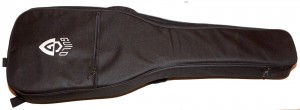 The goto means of conveyance for the lower-priced Newark Street Guilds is the Guild Deluxe Electric Gig bag. It’s functional and it protects the guitar well enough, but the guitar can flop around a bit inside since it’s not a custom-fitted solution. I’ll always prefer a hard case, and if I’m using a soft case my preferred solution is the iGig G515, but since this is basically a $500 guitar and is not really all that fragile, I’m probably not going to put it into a $230 case unless I’m taking it on a plane. Also, as a frequent flyer who flies upwards of 70 times a year, I’d never take a guitar on a plane, but that’s a rant for another time.
The goto means of conveyance for the lower-priced Newark Street Guilds is the Guild Deluxe Electric Gig bag. It’s functional and it protects the guitar well enough, but the guitar can flop around a bit inside since it’s not a custom-fitted solution. I’ll always prefer a hard case, and if I’m using a soft case my preferred solution is the iGig G515, but since this is basically a $500 guitar and is not really all that fragile, I’m probably not going to put it into a $230 case unless I’m taking it on a plane. Also, as a frequent flyer who flies upwards of 70 times a year, I’d never take a guitar on a plane, but that’s a rant for another time.
Finish
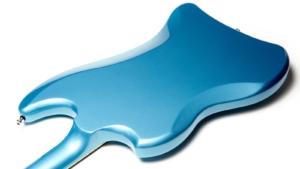 The finish is poly and has a bit of that candy-coated shell vibe going on, but that really doesn’t take away from the playability or tonality of the guitar. This is not a $4000 Custom Shop instrument, remember, and for the price I think the finish is rock solid.
The finish is poly and has a bit of that candy-coated shell vibe going on, but that really doesn’t take away from the playability or tonality of the guitar. This is not a $4000 Custom Shop instrument, remember, and for the price I think the finish is rock solid.
Though the T-Bird STs technically come in Red, White, and Blue (‘Merica!), the option with the P90 pickups only comes in blue. That’s a bit of a bummer because the red finish is really nice and a fair number of people I’ve talked to don’t like the faux-toriseshell pick guard. I’m fine with it and I like the overall look of the guitar so I haven’t modded it. Yet.
The finish on the guitar is actually sparkly when viewed up close, but that’s not immediately obvious from a distance. It’s actually a really cool color and I have to say that I was impressed by the finish. Though this guitar did not cost much, it is by no means a “cheap” guitar.
Fretboard and Neck
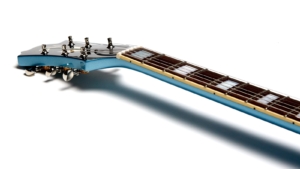 This is a short-scale guitar at 24 3/4″ and the fretboard is bound rosewood with some very nice looking simple rectangular inlays. The neck is a very comfortable C shape with a surprising .85″ depth at the nut which gives this guitar great playability when coupled with the width which I measured at 1 23/32″ at the nut. For those that hate fractions, that’s halfway between 1 11/16″ and 1 3/4″! For those that live somewhere in the world that has a sane measuring system, the neck measures 1.72mm at the nut.
This is a short-scale guitar at 24 3/4″ and the fretboard is bound rosewood with some very nice looking simple rectangular inlays. The neck is a very comfortable C shape with a surprising .85″ depth at the nut which gives this guitar great playability when coupled with the width which I measured at 1 23/32″ at the nut. For those that hate fractions, that’s halfway between 1 11/16″ and 1 3/4″! For those that live somewhere in the world that has a sane measuring system, the neck measures 1.72mm at the nut.
I measured the fretboard radius to be 12″, but the difference between 10″ and 12″ is subtle on a good day and since the webpage lists the radius as 10″, I’ll chalk the difference up to possible error on my part.
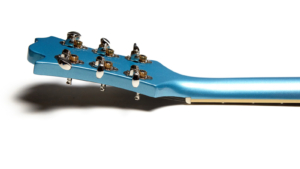 The headstock break angle is pretty severe and care should be taken with this guitar given the fact that the rest of it is basically a flat slab of mahogany. That means that when laid down flat on the ground (or, you know, dropped there) the tip of the headstock will be the first thing to make contact with the floor which is a recipe for a break. Take extra care when putting this guitar down between sets, and since the guitar usually comes in a gig bag and not a hard case, when traveling as well.
The headstock break angle is pretty severe and care should be taken with this guitar given the fact that the rest of it is basically a flat slab of mahogany. That means that when laid down flat on the ground (or, you know, dropped there) the tip of the headstock will be the first thing to make contact with the floor which is a recipe for a break. Take extra care when putting this guitar down between sets, and since the guitar usually comes in a gig bag and not a hard case, when traveling as well.
Build Quality
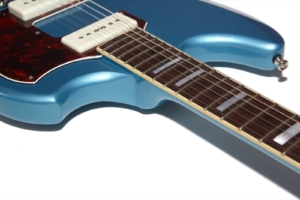 This is a very solid instrument that feels quite good in the hand. There is nothing on this guitar that feels cheap and if not for decades of experience that has turned me into a vintage gear snob, I’d have no problems playing this guitar anywhere its tonal character fit the need. Though it’s possible that components may wear out over time, I see no obvious reason to expect that.
This is a very solid instrument that feels quite good in the hand. There is nothing on this guitar that feels cheap and if not for decades of experience that has turned me into a vintage gear snob, I’d have no problems playing this guitar anywhere its tonal character fit the need. Though it’s possible that components may wear out over time, I see no obvious reason to expect that.
Import guitars for someone of my age (don’t ask) are always suspect because when I was a teen in the ’70s and ’80s, most of the import guitars available to me were frankly garbage. That’s not true today and I would have killed for a guitar of this quality for the price when I was first learning. I’ve been critical of quality control issues on Guild Newark Street guitars in the past, but this guitar really doesn’t have any flaws that I could complain about.
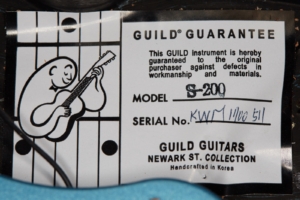 The neck is a set-neck design like many Guild electrics and it feels rock solid to me. This guitar weighs 6.86 pounds which is almost a pound lighter than the red T-Bird ST (7.76 lbs) that I have.
The neck is a set-neck design like many Guild electrics and it feels rock solid to me. This guitar weighs 6.86 pounds which is almost a pound lighter than the red T-Bird ST (7.76 lbs) that I have.
One thing that surprised me when I opened the guitar up was the sticker that I found underneath the electronics. A couple of things grabbed me, the first being the fact that Guild has brought back the ghost logo which was commonly seen on guitars from the Hoboken days. The sticker is actually a very close copy of the Hoboken-era stickers with the surprising guarentee verbiage intact and the name and address of Guild having been changed.
The other thing that struck me about the sticker is the model which is clearly shown to be S-200 even though the Guild catalog and website show no mention of the S-200 model number for the non-vibrato models. My assumption is that the bodies for all of the T-Bird variants are the same and that the electronics and tailpiece are added after the fact, but I have nothing to base that on aside from the sticker and the idea that it would simplify the manufacturing process.
Pickups
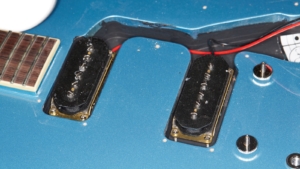 This guitar’s main selling point is quite obviously the pickups, so how do they perform? They are advertised as being Dual Franz P90 Soapbars, and from a physical design standpoint they do resemble a pair of vintage Franz pickups right down to the impossible to adjust mounting system that requires the pickguard to be off and the strings to be on if you want to adjust them while testing. Seriously, this annoyed me to no end because you can’t just twiddle a couple of adjustment screws like you can on most setups – you have to remove the pickguard, restring the guitar, play and adjust the setup (possibly including spacers) and then put it all back together when you’re done. I get that these are copies of some 1950s technology, but man, that’s one aspect of vintage that could have happily forgone. Of course, the individual poles are adjustable so I could just be yelling at clouds, which is a proud tradition of my people (old white guys).
This guitar’s main selling point is quite obviously the pickups, so how do they perform? They are advertised as being Dual Franz P90 Soapbars, and from a physical design standpoint they do resemble a pair of vintage Franz pickups right down to the impossible to adjust mounting system that requires the pickguard to be off and the strings to be on if you want to adjust them while testing. Seriously, this annoyed me to no end because you can’t just twiddle a couple of adjustment screws like you can on most setups – you have to remove the pickguard, restring the guitar, play and adjust the setup (possibly including spacers) and then put it all back together when you’re done. I get that these are copies of some 1950s technology, but man, that’s one aspect of vintage that could have happily forgone. Of course, the individual poles are adjustable so I could just be yelling at clouds, which is a proud tradition of my people (old white guys).
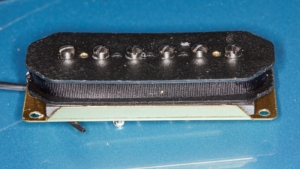 The bridge pickup measured 7.6k Ω on my Fluke multimeter while the neck measured 7.1k Ω which I found interesting because Guild advertises the bridge to be 6.67k Ω and the neck to be 6.67k Ω as well, but that could be a simple copy/paste mistake on the website. The wiring build on my pickups is slightly different from what I’ve seen on other Newark Street Guilds. My guitar has soldered connections while the ones for sale on Guild’s site have quick disconnects. I’ve seen different version of the LB1 pickups with similar discrepancies, so that’s likely just a year or version change.
The bridge pickup measured 7.6k Ω on my Fluke multimeter while the neck measured 7.1k Ω which I found interesting because Guild advertises the bridge to be 6.67k Ω and the neck to be 6.67k Ω as well, but that could be a simple copy/paste mistake on the website. The wiring build on my pickups is slightly different from what I’ve seen on other Newark Street Guilds. My guitar has soldered connections while the ones for sale on Guild’s site have quick disconnects. I’ve seen different version of the LB1 pickups with similar discrepancies, so that’s likely just a year or version change.
That fat P90 snarl is absolutely there on the bridge pickup and the neck pickup delivers the even fatter thick creamy tone that I love through an overdriven Marshall. The downside, as with all single coil pickups, is that they are absolute humming machines and will pickup up any 60-cycle (or 50-cycle for you Brits) noise from within about a three-mile (or 2.6 nautical miles for you sailors and pilots) radius. The good news is that in the middle position the hum instantly disappears. There is also a sort of quacky vibe to it that works quite well on this guitar when in the middle position.
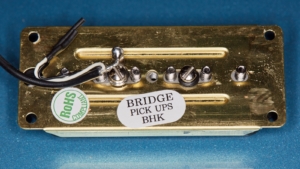 I dont have any direct experience with vintage Franz pickups, but based on things I’ve read from people I trust, the pickups in this Guild seem to sound more like Gibson P90s than vintage Franz P90s. If the Guild website is to be believed then these pickups have Alnico II magnets and my favorite P90s have always been made with Alnico IIs as opposed to the seemingly more common Alnico Vs, so I consider that a plus.
I dont have any direct experience with vintage Franz pickups, but based on things I’ve read from people I trust, the pickups in this Guild seem to sound more like Gibson P90s than vintage Franz P90s. If the Guild website is to be believed then these pickups have Alnico II magnets and my favorite P90s have always been made with Alnico IIs as opposed to the seemingly more common Alnico Vs, so I consider that a plus.
Though I was happy overall with the pickups for the price, I must say that they don’t compare to a set of good P90s from a boutique maker, but then I need to remind myself that this was basically a $500 guitar and I’ve paid more than that for a set of boutique pickups, but that says more about me than it does the pickups. Also, they’re supposed to sound like Franz pickups and not Gibson P90s, so there’s that. What I can tell you is that they don’t sound like humbuckers which is probably what people are after when buying this guitar, anyway.
Electronics
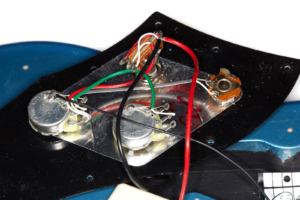 The electronics are fairly simple in this guitar with a master volume, a master tone, and a pickup selector switch. The pots are both 500k, the capacitor is a polyester .022μF of-the-shelf part and the entire build is very much uneventful in its design. The solder connections aren’t the greatest and I had to repair one as a result of the guitar having intermittent cutouts when switching to the bridge pickup, but I consider that to be sort of an import guitar thing. To be more specific, a low-priced import guitar thing.
The electronics are fairly simple in this guitar with a master volume, a master tone, and a pickup selector switch. The pots are both 500k, the capacitor is a polyester .022μF of-the-shelf part and the entire build is very much uneventful in its design. The solder connections aren’t the greatest and I had to repair one as a result of the guitar having intermittent cutouts when switching to the bridge pickup, but I consider that to be sort of an import guitar thing. To be more specific, a low-priced import guitar thing.
Having a master tone and volume means giving up a little bit of control, but for someone like me that generally leaves the tone knobs on 10, that’s not a huge deal. The bigger deal is the inability to balance the pickups in the middle position, but that’s also something that I rarely (if ever) do.
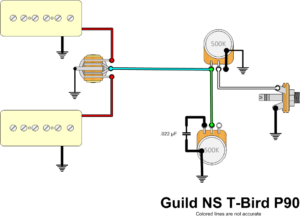 I actually like the simplified control layout and I think it fits inline with the general vibe of the guitar being a simplified version of the complex S200 T-Bird.
I actually like the simplified control layout and I think it fits inline with the general vibe of the guitar being a simplified version of the complex S200 T-Bird.
The parts are all made in Korea which I figured out by the careful examination of the Made in Korea stamps on the pots and the BHK sticker on the pickups which stands for BooHeung Precision Machinery in Korea where the pickups are made. By the way, the number of threads you can find online with people speculating what BHK stands for is pretty remarkable, but I attribute that to the lack of the word Korea on the pickups and the fact that so many guitar Brands use the company for pickups on their import guitars.
Hardware
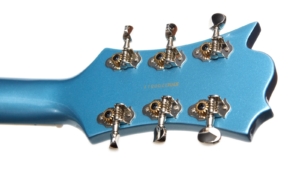 The tuners are Grover Sta-Tites similar to those found on other Guild Newark Street instruments. I’m a pretty vocal about my dislike of these tuners partially because I don’t like the look of open gear tuners on electric guitars, but mostly because as someone with large hands I really dislike the tiny tuning buttons. They keep the guitar in tune well enough, so I guess I shouldn’t complain too much unless more clouds appear.
The tuners are Grover Sta-Tites similar to those found on other Guild Newark Street instruments. I’m a pretty vocal about my dislike of these tuners partially because I don’t like the look of open gear tuners on electric guitars, but mostly because as someone with large hands I really dislike the tiny tuning buttons. They keep the guitar in tune well enough, so I guess I shouldn’t complain too much unless more clouds appear.
The knobs are copies of the vintage G-shield knobs that are labeled Volume and Tone with numbers ranging from 1-9. The strap pegs are minimal and offer no locking of any kind though they function the same as any number of vintage instruments which have all had their strap pegs replaced with locking options years ago.
The website says that the nut is bone and short of filing it a bit to see if I can smell the proof, I don’t know how to prove that. I will say that the nut is cut well and does not impede tuning at all, so I’ve got nothing to complain about there which is good because I’ve had issues with poorly cut nuts on other Newark Street guitars.
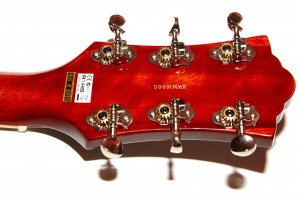 Guild used to ship Korean-made guitars with stickers on the back of the headstock showing ROHS compliance along with Made in Korea as shown on this picture of my Newark Street Bluesbird from 2016. I’ve noticed quite a few Newark Street Guilds out in the world without these stickers and that concerns me because I’ve seen sellers on sites like eBay and Reverb selling import Guilds as if they were US-made and to the untrained eye, the differences may not be obvious. That being the case, there is no requirement for the stickers to remain after delivery to the original purchaser so I’d like to assume that the stickers have been removed after Guild sold the guitar. Still, I see ads like this one from Sweetwater that shows this very model guitar without the stickers so I have to wonder what’s going on. In the case of this model there is no US-made version so the point is probably moot, but if you have details about why the sticker situation has changed please leave a comment.
Guild used to ship Korean-made guitars with stickers on the back of the headstock showing ROHS compliance along with Made in Korea as shown on this picture of my Newark Street Bluesbird from 2016. I’ve noticed quite a few Newark Street Guilds out in the world without these stickers and that concerns me because I’ve seen sellers on sites like eBay and Reverb selling import Guilds as if they were US-made and to the untrained eye, the differences may not be obvious. That being the case, there is no requirement for the stickers to remain after delivery to the original purchaser so I’d like to assume that the stickers have been removed after Guild sold the guitar. Still, I see ads like this one from Sweetwater that shows this very model guitar without the stickers so I have to wonder what’s going on. In the case of this model there is no US-made version so the point is probably moot, but if you have details about why the sticker situation has changed please leave a comment.
The bridge is listed as being a Guild Tune-O-Matic but it looks like an off-the-shelf part to me. The tailpiece is similarly generic looking, though both are of sufficient quality to not cause a concern.
When removing the pick guard I noticed that five of the screws are longer than the rest and snapped this pic showing four of the five screws. The last screw that was longer is the one in the middle of the bottom curve of the pick guard that is closest to the output jack. I figured anyone who took that guard off and didn’t pay attention would be thankful for the information.
Sound
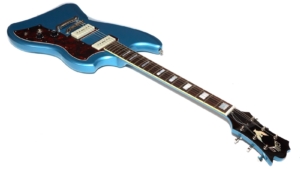 I like the tones I can get from this guitar. It’s got a different character than the same model with the LB1 pickups, and the tone can get that great raw P90 snarl that I love so much. With the exception of the single-coil hum, this guitar really produces a lot of bang for the buck, and single-coil hum is part of the fun so complaining about that is counter-productive.
I like the tones I can get from this guitar. It’s got a different character than the same model with the LB1 pickups, and the tone can get that great raw P90 snarl that I love so much. With the exception of the single-coil hum, this guitar really produces a lot of bang for the buck, and single-coil hum is part of the fun so complaining about that is counter-productive.
ODS100 Clean
7th Chords
Open Chords #1
Open Chords #2
JCM-800
A Barre Chords
D-Shape Chords
[/dropshadowbox]These recordings were among the last I did using my Axe-FX II XL+ setup before I upgraded to the Axe-FX III. I played through the QSC K12 speaker recorded direct into my Macbook Pro using Audacity. I recorded using the ODS100 Clean patch, as well as the JCM-800.
For each recording I cycle through the neck pickup, both pickups, and finally the bridge pickup. All knobs on the guitar are on 10 at all times.
Again, I think it sounds more like an Alnico-II P90 guitar than a vintage Franz P90, but I’m not sure someone buying this guitar cares much about that distinction. Thanks to the pickups not being mismatched like they are with the LB1 pairs, the guitar behaves the way you’d expect with the bridge pickup being hotter and having more bite than the neck.
Playability
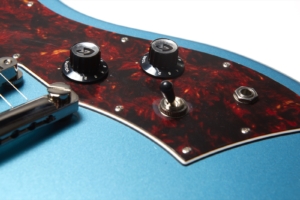 This guitar plays great while sitting, standing, and everything in-between, though having just written that I’m kind of chuckling at playing a guitar somewhere between sitting and standing. It balances well while standing and sits on my knee well while sitting. Upper fret access is reasonably good but not super-Strat good, but then this guitar doesn’t really appear to be made to challenge the super-Strat market.
This guitar plays great while sitting, standing, and everything in-between, though having just written that I’m kind of chuckling at playing a guitar somewhere between sitting and standing. It balances well while standing and sits on my knee well while sitting. Upper fret access is reasonably good but not super-Strat good, but then this guitar doesn’t really appear to be made to challenge the super-Strat market.
The guitar can feel a little odd because the body is so long and there’s a lot of it behind the tailpiece, but that’s not a problem so much as something that I noticed while playing.
I’d say the best comparison to other guitars I could make is to that of a P90-equipped Gibson SG. There’s something great about the tone of P90 pickups on a slab of mahogany and the SG or Les Paul Jr. nails that tone. I have to say that this guitar kind of does as well. I think the pickups are a touch more polite than I’d prefer, but if I’d never played the boutique P90s that I have in my other guitars I’d never know to even make that distinction.
Conclusion
This guitar surprised me because I’d come to expect a certain amount of missed quality control in Newark Street guitars after some less than perfect experiences. This guitar, though, was pretty darn solid. I found nothing to really complain about and was then pretty blown away by the playability and tones coming from this guitar.

If the guitar has any flaw at all I’d have to say it’s the annoying hum that the single-coil pickups, well, pickup because that problem is mitigated by using the middle position which cancels that hum right out. This is also not a fair thing to complain about since the guitar is a P90-equipped instrument and playing P90s means dealing with hum.
I’m here to tell you that for the price you got a LOT of guitar with the T-Bird P90. I’ve played a lot of guitars in my lifetime and there’s a difference between an inexpensive guitar and a cheap one. This guitar may be inexpensive, especially on the used market, but if you’re after that P90 snarl and you’re tired of the Gibson game, this is a great guitar to consider for not a lot of money.
Donate: PayPal Crypto:
ETH: 0x0AC57f8e0A49dc06Ed4f7926d169342ec4FCd461
Doge: DFWpLqMr6QF67t4wRzvTtNd8UDwjGTQBGs

